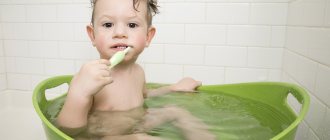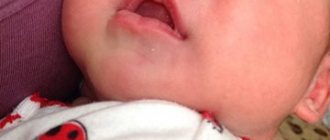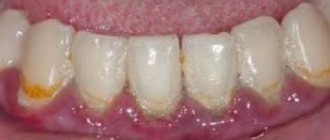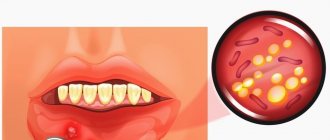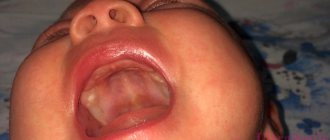Plaque on the teeth of children is a fairly common occurrence, primarily in cases where insufficient attention is paid to oral hygiene. Plaque itself is a collection of food debris, bacteria and elements of the oral mucosa. Initially, it has a soft structure, so removing it from the surface of the teeth is not difficult, but later it quickly hardens and cannot be removed with a simple toothbrush.
Dental plaque varies in color, from almost white to brown and black. The chemical composition of such formations is formed 80% from water, and the rest is formed by fluorides, calcium, phosphorus compounds and other elements.
Stages of plaque formation
Plaque on the teeth of children does not form immediately, but sequentially, going through several stages:
- Pellicle formation. This is an organic film of minimal thickness, the basis of which is the glycoprotein components that make up human saliva. This film is characterized by the absence of microorganisms in it.
- Precipitation of bacteria. Over time, the number of microorganisms consistently increases due to the appearance of new films, which in turn causes an increase in the thickness of deposits formed on the surface of the teeth.
- Actions of anaerobic agents. In air conditions, bacteria are active, resulting in the release of acid. This, in turn, affects tooth enamel, washing away minerals from it.
- Formation of an anaerobic environment. At this stage, the density of deposits increases to a state in which it is not possible to remove them with saliva or rinsing the mouth. The enamel is actively losing minerals.
The rate of formation of deposits on teeth is largely individual. It depends on the composition of saliva, the intensity of epithelium changes, a person’s tendency to inflammation, and so on.
How to detect dark plaque in time
- regularly examine the child’s oral cavity independently;
- do not postpone scheduled visits to the dentist.
It must be taken into account that Priestley plaque on the teeth often accumulates slowly, which is why the child gets used to the stains on the enamel and does not tell his parents about them. Darkening of teeth can occur quickly, literally overnight. Reactive appearance most often occurs during illness, accompanied by intoxication, dehydration and increased body temperature. This is due to the fact that the child’s body reacts sharply to various changes in diet, the functioning of internal organs and in external conditions.
Deposits most often occur at the age of 2-3 years. However, they can also appear on the very first milk teeth of a one-year-old child. Or it could affect the baby teeth of a younger teenager who haven’t had time to change. The darkening may also spread to permanent teeth.
Main reasons
When plaque occurs on the teeth of children over two years of age, there may be several reasons for this phenomenon, but the main ones are:
- Fungal infections developing in the oral cavity;
- Dysbacteriosis;
- Lack of proper oral hygiene;
- Excessive amount of sweets consumed with a shortage of fruits and vegetables;
- Bottle feeding babies at night;
- Chewing food on one side (plaque forms on the other side).
In what places does it usually occur?
In preschool children, plaque appears on the entire surface of the tooth, settling in large quantities in the cervical area. Later, in the absence of hygiene, layers of plaque can increase to the middle of the tooth and then they can be seen with the naked eye.
In children whose teeth are brushed by their parents or who try to carry out regular hygiene themselves, plaque may remain in the interdental space or fissures , where it is not always possible to reach with a brush.
The main dangers of dental plaque
Such deposits, regardless of their color, are a breeding ground for various bacteria, so they pose a danger to the child and require prompt removal. At the same time, the waste products of such microorganisms have an acidic environment, which has a destructive effect on tooth enamel.
In this case, the following diseases may become further development of plaque:
- Destruction of enamel;
- Formation of tartar;
- Caries;
- Gingivitis (inflammation of gum tissue);
- Periodontitis.
What methods are there to remove?
Any plaque must be cleaned off, because it is a breeding ground for bacteria that poison the entire body.
Suitable for cleaning white deposits in the traditional way.:
- a piece of gauze wrapped around an adult’s finger and moistened with boiled water is perfect for the first teeth of children under one year old;
- The silicone brush also fits onto an adult’s finger and gently cleanses weak enamel without damaging it;
- Using toothpaste that is intended for young children and is safe to swallow;
- eating hard fruits that have to be chewed (children from 2 years old minimum).
You can start using the paste in children over 1 year of age by squeezing a small pea onto a silicone brush or a regular one that is appropriate for age.
Traditional medicine recipes can also be useful in the fight to get rid of soft plaque. The following are considered relatively safe for children :
- Baking soda . Dip the brush a little in baking soda and lightly brush your teeth. This method is effective, but with frequent use it severely damages the enamel.
- A piece of lemon . You need to carefully anoint your child's teeth with it. The acid will dissolve the plaque, but if the child complains of pain, you should immediately finish the procedure and rinse your mouth.
- Eggplant peel . Sear the vegetable over the fire over the stove, and then pour the charred peel into a small container. Rub vegetable ash onto your teeth and then rinse.
- Strawberry puree . The berries should be mashed and applied to the teeth. The plaque will dissolve under the influence of acid.
- Activated carbon . Crush 1 tablet into powder and mix with a few drops of water. Dip a brush into the mixture and brush your teeth for at least 2 minutes. Finally, rinse your mouth.
- Infusion of horsetail . The popular name is "cleaner". For cooking you will need 30 grams. dried plant, filled with 1 cup of boiling water. Let it brew, and then take 1 tsp orally. twice a day for 3 weeks. This is only suitable for teenagers and adults.
Traditional medicine should be used on children with great caution, because it is unknown how their body will react.
Possible color of plaque on teeth
- Yellow. Such plaque in most cases is the result of insufficient oral hygiene. If the thickness of the layer of formations turns out to be significant, you should consult a dentist.
- Brown color. Indicates deposits containing iron. They can be caused by taking iron-containing drugs or increased levels of this metal in drinking water.
- Green color. Characteristic of a situation where chlorophyll-containing microorganisms develop in the child’s mouth. Most often, such plaque does not form on the teeth, but on the inner surfaces of the lips and cheeks in the area of the patient’s front teeth.
- White color. The safest of all types of plaque is white. It indicates a lack of hygiene. It is enough to regularly brush and rinse your teeth, starting from the moment the first teeth appear, and it will definitely disappear.
- Black or dark green color. It is called Prisley plaque and is very difficult to clean off. It is mainly characteristic of baby teeth, and gradually goes away as the child develops a correct bite.
The reason for the dark color of Prisley's plaque is the bacteria Actinomycetes and Lactobacillus, which create a dark pigment in the process of their own vital activity.
Today, medicine has not yet fully determined the causes of the occurrence and spread of such bacteria in the oral cavity, but it is believed that problems with the gastrointestinal tract may be the cause. In such conditions, a trip to a gastroenterologist will not be superfluous.
A number of researchers indicate that children with such plaque have a slightly changed composition of saliva, where there is much more pH, calcium and a number of other elements. As a result, such saliva is more dense in its structure.
At the same time, it is impossible to remove plaque on children’s teeth on their own; you will need to go to a dental clinic.
White spots on baby teeth in an infant and older child
This is an alarming symptom that requires urgent consultation with a pediatric dentist. Some parents mistakenly believe that there is no need to treat the first teeth, because they will soon fall out and be replaced by permanent ones. This is a misconception that can cost your oral health.
Whitening of areas indicates their demineralization. If urgent measures are not taken, the unit may simply fall out or split into several fragments. As a result, the rudiments of new incisors, canines and molars are damaged. You won't be able to deal with this on your own. For treatment, therapeutic tactics are developed together with an experienced specialist in the field of pediatric dentistry.
Products that improve enamel color
To help prevent darkening of your teeth:
- nuts (contain vitamins necessary for the proper formation of enamel);
- apples and pears (contain fruit acids and water);
- strawberries, wild strawberries (have whitening properties);
- broccoli (removes dark colored deposits).
As soon as the child's teeth have formed, he must be gradually introduced to solid food. Let him nibble on carrots and green apples: in addition to saturating the body with vitamins, they help clean off soft deposits.
Give your child more dairy products. But sweets should be limited: they create an excellent breeding ground for bacteria.
Plaque turns brown
This is evidence of sediment mineralization. Most likely, they became hard and turned into tartar.
The stone is formed from the inside, but can also be found on the outside. You cannot deal with it on your own: the dentist is working to remove such plaque.
If you see not only dark plaque on your baby’s teeth, but also small irregularities, dots, and shading, it is likely that the child has fluorosis.
It is caused by excess fluoride. They are treated with specially selected fluoride-free pastes and drinking water passed through a filter. Only a doctor can make a diagnosis.
Brown plaque in infants
Your baby has not yet switched to foods from the adult table, but has he already developed a brown coating? Causes:
- sweet additives in the diet;
- night feedings;
- illnesses the mother suffered during pregnancy.
Caries can develop even before the baby's first year has passed if you offer him a lot of sweet drinks and purees.
Night feedings are another reason. At night, saliva is produced in smaller quantities, so if a child drinks milk, the teeth are not so intensively washed with salivary fluid and are not cleaned. Bacteria settle on them, causing gradual darkening and hardening of the deposits. The result is caries.
If a woman suffered severe toxicosis or was ill while carrying a child, her body felt a lack of essential vitamins and microelements. Therefore, the laying of the baby’s first teeth occurred “with errors”: the milk teeth, growing, quickly became affected by caries.
When to start brushing your child's teeth
Caring for the oral cavity of a newborn means periodic examination. But as soon as the first tooth appears, brush it. The baby's first brush is a special fingertip for the mother, one side of which is covered with soft short bristles. Put it on and massage your teeth. This should not cause any discomfort to the baby.
Dr. Komarovsky advises starting full-fledged care from the age of one and a half years. He names the main reasons for the transformation of enamel shade in children:
- metabolic disease;
- lack of calcium and vitamin D;
- indoor air is too dry;
- insufficient functions of saliva.
A dental examination of baby teeth is mandatory. The doctor will find the root of the problem and tell you how to eliminate the cause of the formation.
Advice from Dr. Zubastik
Have you discovered that your baby’s teeth are covered with plaque? Try cleaning them first or watch your child do this procedure. If deposits remain, make an appointment with your dentist. He will take action: he will explain what to add to your diet when caring for your teeth so that the enamel does not change shade, and, if necessary, he will perform silver plating or put a filling.
For certain indications, a child over 10 years old is allowed to have their teeth brushed. This procedure may be necessary in your case.
Keep an eye on your child’s teeth – this is an indicator of the general state of the immune system. Are they white and strong? Congratulations, your young heir can boast of excellent health!
Plaque and tartar
Essentially, these are 2 stages of one process. You can figure out whether there are hard deposits on your teeth by looking at the plate below:
| Signs | Raid | Tartar |
| Color | Any: from white to black. Comes with a greenish tint | Color from dark yellow to dark brown |
| Location | On any surface | More often, where it is difficult to clean your teeth well: on the inside of the front teeth, in the spaces between teeth, close to the gums. More often seen with crowded teeth |
| What cleaning methods does it lend itself to? | Clean with a brush with paste or homemade bleaching products, such as lemon | Can't remove it at home |
If you see plaque on your baby that cannot be removed with a brush, it’s time to visit a doctor.
